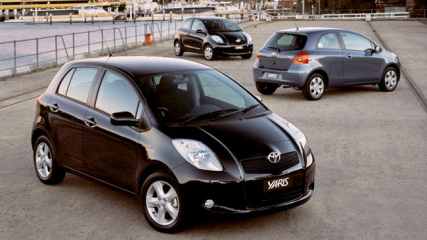Used Toyota Yaris review: 2005-2010
By Graham Smith · 03 Dec 2012
Small cars are in, in fashion that is, since downsizing became sensible in this gridlocked world. In the shrinking process they became serious cars for most people rather than cars just for the impoverished.NEWMarketing men threw around words like, refined, sophisticated, funky and safe, words that were once unheard when the conversation turned to mini motors. The Yaris was Toyota's entry in the new small car world, and you guessed it, it was bigger and more refined.The stylish newcomer had broad appeal with the choice of 3-door hatch, 4-door sedan and 5-door hatch body styles, two engines, and the option of 5-star safety. If compared to its predecessor, the Echo, the Yaris comes up trumps for it roominess and comfort. Front seat passengers treated to improved comfort and rear seat occupants given more space.The two engines on offer were a 1.3-litre four-cylinder unit that delivered 63 kW and 121 Nm, and a 1.5-litre four-cylinder unit that gave a more appealing 80 kW and 141 Nm. With extra power and torque, and only marginally more fuel consumption, the larger engine is clearly the one to go for.It delivers smooth drivability and sits comfortably on the highway speed limit, and only uses a little more fuel than the smaller unit, which has to work harder to get the job done. Yaris buyers could choose between a 5-speed manual gearbox and a four-speed automatic.The auto didn't have a manual mode, but that's nothing to be concerned about, those systems aren't often used in any case. Road testers at the time were high in praise for the Yaris's comfort and build quality, rating it higher than its rivals. Its ride was rated as comfortable, its handling responsive, the only criticism that consistently came to the fore was a jerky throttle.NOWToyota vehicles have a perception of perfection when it comes to quality and reliability, but the reality is that they can break down like any other car. But the Yaris is generally sound and has no serious flaws that would cause potential buyers any concern.The engines are robust and reliable, and the same goes for the transmissions and drivelines. Reports we have received from Yaris owners show that they are happy with the reliability of their cars, and they like the resale value, both laudable attributes in a car.On top of that they praise the roomy cabin, the storage space, the performance and the fuel economy. Their criticisms are that the headlights are inadequate outside the urban area, the seats are small and unsupportive, the throttle is jerky and the front grounds out when crossing drains and gutters.Check for a service record that shows a regular routine of servicing. Like all modern cars the Yaris thrives on fresh oil and clean filters, fail to service them only leads to greater expense long term. Being a small car and often bought by those on a tight budget, servicing can be neglected, with some owners hoping to pass the car on before trouble strikes.SMITHY SAYS If you're a small shopper give the Yaris a go, it's a good little car. 4 starsToyota Yaris 2005-2010Price new: $16,490 to $21,790Engine: 1.3-litre 4-cylinder, 63 kW/121 Nm; 1.5-litre 4-cylinder, 80 kW/141 NmTransmission: 4-speed automatic, 5-speed manualEconomy: 6.0-6.1 L/100 kmBody: 3-door hatch, 4-door sedan, 5-door hatchVariants: YR, YRS, YRXSafety: 4-star ANCAP, 5-star with safety pack




